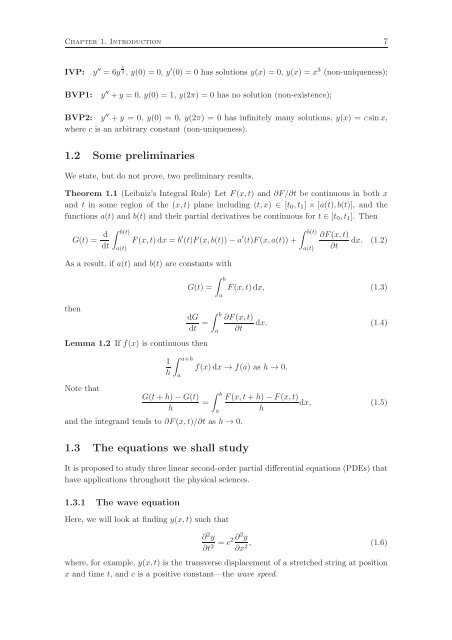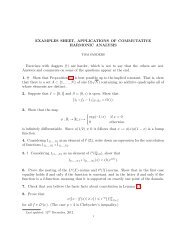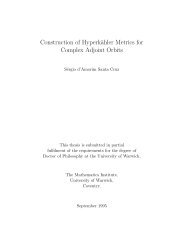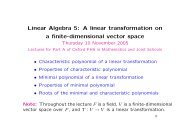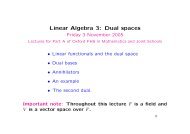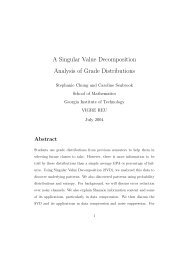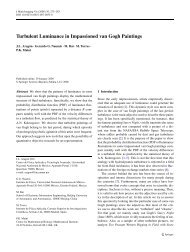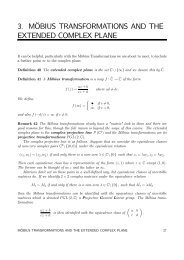Fourier Series and Partial Differential Equations Lecture Notes
Fourier Series and Partial Differential Equations Lecture Notes
Fourier Series and Partial Differential Equations Lecture Notes
Create successful ePaper yourself
Turn your PDF publications into a flip-book with our unique Google optimized e-Paper software.
Chapter 1. Introduction 7<br />
IVP: y ′′ = 6y 1<br />
3, y(0) = 0, y ′ (0) = 0 has solutions y(x) = 0, y(x) = x3 (non-uniqueness);<br />
BVP1: y ′′ +y = 0, y(0) = 1, y(2π) = 0 has no solution (non-existence);<br />
BVP2: y ′′ + y = 0, y(0) = 0, y(2π) = 0 has infinitely many solutions, y(x) = csinx,<br />
where c is an arbitrary constant (non-uniqueness).<br />
1.2 Some preliminaries<br />
We state, but do not prove, two preliminary results.<br />
Theorem 1.1 (Leibniz’s Integral Rule) Let F(x,t) <strong>and</strong> ∂F/∂t be continuous in both x<br />
<strong>and</strong> t in some region of the (x,t) plane including (t,x) ∈ [t0,t1] × [a(t),b(t)], <strong>and</strong> the<br />
functions a(t) <strong>and</strong> b(t) <strong>and</strong> their partial derivatives be continuous for t ∈ [t0,t1]. Then<br />
G(t) = d<br />
dt<br />
b(t)<br />
a(t)<br />
F(x,t)dx = b ′ (t)F(x,b(t))−a ′ b(t) ∂F(x,t)<br />
(t)F(x,a(t)) + dx. (1.2)<br />
a(t) ∂t<br />
As a result, if a(t) <strong>and</strong> b(t) are constants with<br />
then<br />
Lemma 1.2 If f(x) is continuous then<br />
Note that<br />
1<br />
h<br />
b<br />
G(t) = F(x,t)dx, (1.3)<br />
a<br />
dG<br />
dt =<br />
b ∂F(x,t)<br />
dx. (1.4)<br />
a ∂t<br />
a+h<br />
f(x)dx → f(a) as h → 0.<br />
a<br />
G(t+h)−G(t)<br />
h<br />
b<br />
=<br />
<strong>and</strong> the integr<strong>and</strong> tends to ∂F(x,t)/∂t as h → 0.<br />
1.3 The equations we shall study<br />
a<br />
F(x,t+h)−F(x,t)<br />
dx, (1.5)<br />
h<br />
It is proposed to study three linear second-order partial differential equations (PDEs) that<br />
have applications throughout the physical sciences.<br />
1.3.1 The wave equation<br />
Here, we will look at finding y(x,t) such that<br />
∂2y ∂t2 = c2∂2 y<br />
∂x2, (1.6)<br />
where, for example, y(x,t) is the transverse displacement of a stretched string at position<br />
x <strong>and</strong> time t, <strong>and</strong> c is a positive constant—the wave speed.


